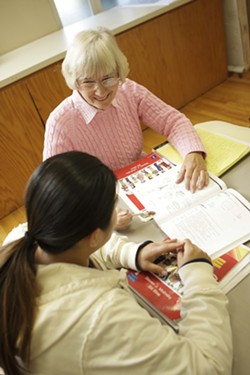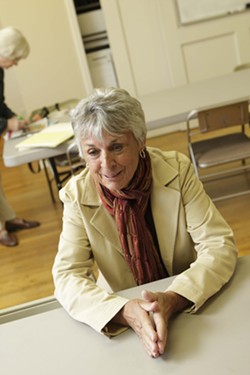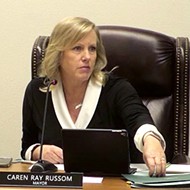[{
"name": "Ad - Medium Rectangle CC01 - 300x250",
"id": "AdMediumRectangleCC01300x250",
"class": "inlineCenter",
"insertPoint": "8",
"component": "2963441",
"requiredCountToDisplay": "12"
},{
"name": "Ad - Medium Rectangle LC01 - 300x250",
"id": "AdMediumRectangleCC01300x250",
"class": "inlineCenter",
"insertPoint": "18",
"component": "2963441",
"requiredCountToDisplay": "22"
},{
"name": "Ad - Medium Rectangle LC09 - 300x250",
"id": "AdMediumRectangleLC09300x250",
"class": "inlineCenter",
"insertPoint": "28",
"component": "3252660",
"requiredCountToDisplay": "32"
}]
If you’re reading this right now, count yourself lucky: You’re not among the estimated 21 to 23 percent of American adults who are either wholly illiterate, functionally illiterate (those who might be able to understand a couple thousand words memorized by sight in grade school but who are unable to understand such basic written instructions as warning labels or driving directions), or have substandard reading skills that negatively affect their earnings.
Studies suggest that among these semi-literate 40- to 44-million American adults, even those who possess some reading skills may lack the ability to locate information in text or make low-level inferences from printed materials.
As a reader, you might think, “Oh, well. That’s their problem, not mine,” but American illiteracy affects us all. A literate workforce is a productive workforce, and semi-literate workers earn far below their literate counterparts, meaning they don’t contribute effectively to our economy.
Furthermore, Americans with reading deficiencies are more likely to require such social services as welfare, food stamps, and Section 8 subsidized housing. They’re more likely to be unable to afford health insurance. They don’t have the means to further their education to improve their condition. In other words, not only are they a drag on the economy, tax dollars may subsidize their needs. Luckily, there’s an organization that does something about this problem.
Learning to read
The Literacy Council of SLO County estimates there are as many as 25,000 functionally illiterate adults in the county. While many of the Literacy Council’s clients are English as a Second Language (ESL) learners, some are native speakers who simply never learned to read and write. For many of them, the hardest step to improving their reading and writing skills is admitting they have a problem and seeking help.
“They are the most difficult learners to walk through our doors,” admitted Executive Director Bernadette Bernardi. “Typically it begins with a phone call: ‘I have a friend who can’t read.’ We do treat native speakers a little differently because most ESL students are really proud to be improving their lives and assimilating into the community, but there’s a certain amount of shame” [that accompanies being an illiterate native speaker].
So who is the Literacy Council there for? The short answer is, Anyone who needs it.
According to their website (sloliteracy.org), the Literacy Council is a “non-profit volunteer organization affiliated with Laubach Literacy International, providing tutoring in English language skills for adult native English speakers and speakers of other languages. The Council coordinates tutoring at learning centers throughout San Luis Obispo County and provides training workshops for tutors.”
Bernardi got her start at the council in 1998 when she became aware of the need.
“I met a man who had worked for city park maintenance for 30 years but who read at a first- or second-grade level,” recalled Bernardi. “If he needed to respond to correspondence, his wife read it for him. So that’s how I came to it—as a tutor. I was originally hired to be a fundraiser, and even now when I get caught up in fundraising and grant writing, I’ll go to one of the centers to be reminded why we do this. Currently we’re vastly under-funded, but we’re a lean, mean machine. We get a lot done with a little.”
Much of the Literacy Council’s funding comes from the State Library system, but in the current state budget situation, those funds are tenuous at best.
“Last year, the legislature threatened to cut the whole thing, but we got together and lobbied and we’re now surviving despite a six percent cut,” said Bernardi. “To make matters worse, private donations are down. Hopefully, if we ever get to the point where we’re talking about closing our doors, the community will rally.”
The illegal alien question
During an economic downtown, immigrants—both legal and illegal—make convenient scapegoats.
“I do get asked about the legal versus illegal immigrants,” said Bernardi, “but our policy is, we don’t ask. If they’re coming for help, we help them because they need help and they’re trying to become members of the community. We just don’t make it our business [what their status is]. All you’d have to do is see these folks who come to us after being in the fields all day; or the Thai person who works all day in a restaurant who after 10 hours comes to the center. They work hard and they’re simply trying to make a better life.”
Proponents of literacy programs argue it’s in the best interest of our country and economy to educate workers, but it remains a point of contention among many who believe tax dollars should never be spent on illegal workers. Ironically, such people frequently complain that immigrants don’t learn English. These attitudes frustrate Bernardi and her team of volunteer tutors.
Dagmar Malkus started volunteering a decade ago. The German native understood the importance of English skills for immigrants in the United States.
“I also couldn’t stand being boxed up in my house,” she laughed, “and I got hooked on tutoring.”
Marty Nelson, a tutor since 2006, also spoke of the intoxicating nature of volunteer tutoring: “This is the most fun thing to do. They appreciate it so much.”
“And it’s one-on-one,” added Malkus. “As tutors, we learn so much more about the world and the people.”
“When we tell students we’re all volunteers, that’s a very strange concept to some of them,” offered Nelson. “They can’t believe we’re doing it for free.”
Not only do tutors work one-on-one with the students, but they keep working with the same student for as long as that student keeps coming. This consistency helps students to become comfortable with the tutors and learn without unnecessary repetition.
The Literacy Council also supplies teaching materials—books for both native speakers and ESL learners. Tutors have even tackled unusual cases.
“One lady had a stroke and lost her capability to read and write—the whole thing,” explained Malkus, who’s especially impressed by how resourceful some of her students are at getting by with limited skills. “I’ve had ESL students say things like ‘Oh, I have such a headache in my back.’ As a tutor, you just need to be flexible, to respond to their needs. I’m amazed at some of their English language survival skills. These are bright, dedicated, intelligent people.”
“It’s very rewarding,” added Karen Wiles, a two-year volunteer. “The three students I work with are very appreciative.”
Elaine Townsend is a real Lit Council veteran, having tutored for 14 years at the SLO Presbyterian Church learning center: “Why do I do it? I was involved in the church and I wanted to volunteer, to do something. It’s very uplifting. I had been involved with assisting people in the homeless population, which was a much sadder situation. I felt like I needed something more positive. I’m a very bookish person and I like to teach, so it seemed like a natural fit.”
“Serving is just who I am in the world,” said Nancy Woodard, “so I always look for the ways to help. I have so much fun with my learners. They all have such a great attitude and we can laugh about the difficulties they have faced and break down the walls of fear. Also, I am always learning something about our language and the origin of words.”
Woodword is also a Learning Center Director.
“I take care in matching up the right tutor and student,” she said. “This can make all the difference. I’ve learned that when the combination is right, learner retention is higher. There is a great camaraderie when volunteers are working toward a common goal. I’m inspired when I see everyone rolling up their sleeves and getting down to work.”
Another Learning Center Director, Lynn Storrs who runs the Arroyo Grande day center at St. John’s Lutheran Church, knows what it’s like to be underestimated: “I’ve been in a wheelchair from the age of 12, so I found it difficult convincing prospective employers that my brain worked even if my legs didn’t.”
After a career in a hospital as an office manager, accountant, and administrator, she turned to volunteerism: “My husband had often talked of his desire to teach adults to read after he retired. He died five years ago after a six-year struggle with lung and brain cancer. Two months after his death, I saw the Literacy Council’s notice of their tutor training classes. I signed up because of my husband’s plans and to keep myself busy doing something useful. I was immediately rewarded by the enthusiasm of the students and other tutors that I worked with.
“Working with these students and making breakthroughs with them is very exciting, and I continue to do it because of that,” continued Storrs. “I became the Arroyo Grande Center Director three years ago. My heart sings when I’m in the hallway by the classrooms and hear all the voices of tutors and students, often laughing, while they work together. I’m very fortunate to have such wonderful tutors.”
Success stories
“We had a man who couldn’t read, but successfully ran his own business,” recalled Lynn Storrs. “It was hard for him to come in the first day or two, but he persevered and did very well. We could see his self-esteem grow as he made progress. By the time he stopped the classes, he was successfully reading short stories, historical essays, and the newspaper. And, he felt good about himself.
“Another man was given a dictionary for Christmas by his sister,” continued Storrs. “It became his prize possession and he loved to use it to learn new words. He proudly told me about now being able to read his Bible with the help of the dictionary and his tutor.
“It’s great when we have students pass their driving tests or get jobs after successful job interviews,” finished Storrs. “These are things our tutors work on with students. We had one student pass her citizenship test last year and we currently have three students studying with their tutors to become citizens. We tutors relearn our history in the process and we all have a great sense of accomplishment.”
How you can help
Some people become tutors, others donate money, but sometimes the most important contribution is guiding someone to the Literacy Council. You can read this, but maybe you know someone who can’t.
“For those who can’t read, I would encourage them to take that first, scary step to join a class through the Literacy Council,” said Storrs. “You will work with just one teacher and not with a group of other people and your privacy will be respected. Being able to read and write better will enrich your life, allow you to get a better job, and you will be rewarded when you are able to read to your children and help them with their homework. A new world will open up to you.”
Contact staff writer Glen Starkey at [email protected].
Latest in News
Readers also liked…
-

Coast Unified teachers upset over new position's salary and qualifications
Oct 20, 2022 -

SLO police identify alleged driver who hit and killed couple
Dec 22, 2022 -

When the levee breaks: Oceano residents, county officials walk a tightrope of regulations to manage Arroyo Grande Creek, which some say led to the levee's failure in January
May 18, 2023













